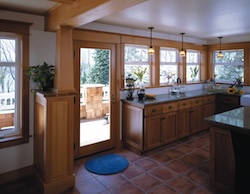Sessions at FGIA Virtual Summer Summit review best practices for installation of residential windows, commercial glazing
Posted on June 19th, 2025
Schaumburg, Illinois – Participants at the Fenestration and Glazing Industry Alliance (FGIA) Virtual Summer Summit heard from speakers about best practices for the installation of both residential windows as well as commercial glazing, each of which can present unique challenges. These two installation sessions were part of a full slate of educational topics discussed during the Summit.
Residential Window Installation | Reviewing Field Issues Related to Water Drainage

“A window is only as good as its installation,” said Anastasio, noting that a mounting flange window (also called a “nail fin window”) has a flange that is used for installation and integration with the drainage plane. It has pre-punched holes or slots used for structural attachment and/or positioning of the product. “Industry standards are important because a manufacturer’s instructions may not allow for different installations or regional considerations,” said Anastasio.
He discussed three applicable standards, all of which help to define an effective water management strategy.
• ASTM E2112 is intended for use in areas with a low risk of wind/water exposure. This standard recommends no sill pan flashing and a continuous seal behind the mounting flange at the sill.
• FMA/AAMA 100 was originally published to address installations in extreme wind/water conditions where there is a high chance of wind/water intrusion. In this method, sill pan flashing is required and a discontinuous seal is utilized behind the mounting flange at the sill. This method assumes some water intrusion could occur, and the sill pan flashing collects and drains any water that enters the rough opening.
• AAMA 502, Voluntary Specification for Field Testing of Newly Installed Fenestration Products, defines a “controlled” and “uncontrolled” path of water and details a sill pan flashing system with a back dam (rear upturned leg) or an interior air seal. Because sill pan flashing is used, the sealant behind the mounting flange at the sill must be discontinuous. Otherwise, water is unable to drain properly.
“The interior seal seems to be the biggest issue,” he said, and encouraged the industry to pay attention to this. “It’s important to follow the standards, review the installation and project needs, and then make a decision on how to move forward, ensuring all are on board,” said Anastasio.
In terms of what method should be used in a given situation, Anastasio said one’s level of risk tolerance will likely be the deciding factor. “Construction has a lot of unknowns, and you can’t control other trades,” he said. “Most leaks are called ‘window leaks’ and must be proven otherwise.”
He recommended consulting FMA/AAMA 100 for guidance.
Commercial Glazing | Reviewing Failures that Impact Best Practices and Quality Control

To reduce risk and provide better outcomes, Dalaba suggested taking a holistic approach. “The parts of the whole are interconnected,” he said. “It’s not just the glazing, it’s how it interfaces with systems, joints, flashing and membrane.” Dalaba said that some common reasons why building enclosures fail include design flaws, maintenance that occurs after installation, installation efforts or construction defects. “We tend to defer to the foreman and their experience, but industry reliance on ‘the people are the process’ is not process control,” he said. Instead, Dalaba said process control involves setting performance standards, measuring actual performance, comparing actual performance with standards, analyzing deviations and then taking corrective actions.
One way to do this is to have a quality management system in place, he said. “The quality manual gives a view of what is in the system, including everything from customer feedback, policies, internal audits, controlling documents and more,” he said. He warned participants not to confuse a quality management system with quality control, however. “A QMS is a managerial tool, whereas quality control is a corrective tool,” he said. “This difference is a common misunderstanding.”
Landis then shared some of the most common issues seen in commercial glazing. “One of the biggest issues we see are joint plugs, or zone dams, not set in sealant the way they were intended,” she said. “There is a critical interface there between the plug and the screw. When it’s not right, the system must be disassembled for repair. Also, sometimes gaskets are not sized correctly, causing issues in the future. A unique one is when weeps are not installed at quarter points of openings. This will cause leakage.”
Schaefer encouraged glazers to determine the root causes. “Ask ‘why did it happen?’ and not necessarily ‘how did it happen?’” he advised. “If screws get torqued down, that is a problem. If fasteners are incorrect, that is a problem. It’s forensic in nature, but so many of these issues have symptoms and you need to determine what the cause may be.”
For more coverage about the FGIA Virtual Summer Summit, visit FGIAonline.org/news.
Your trusted industry resource, setting the standards for fenestration and glazing.
###
